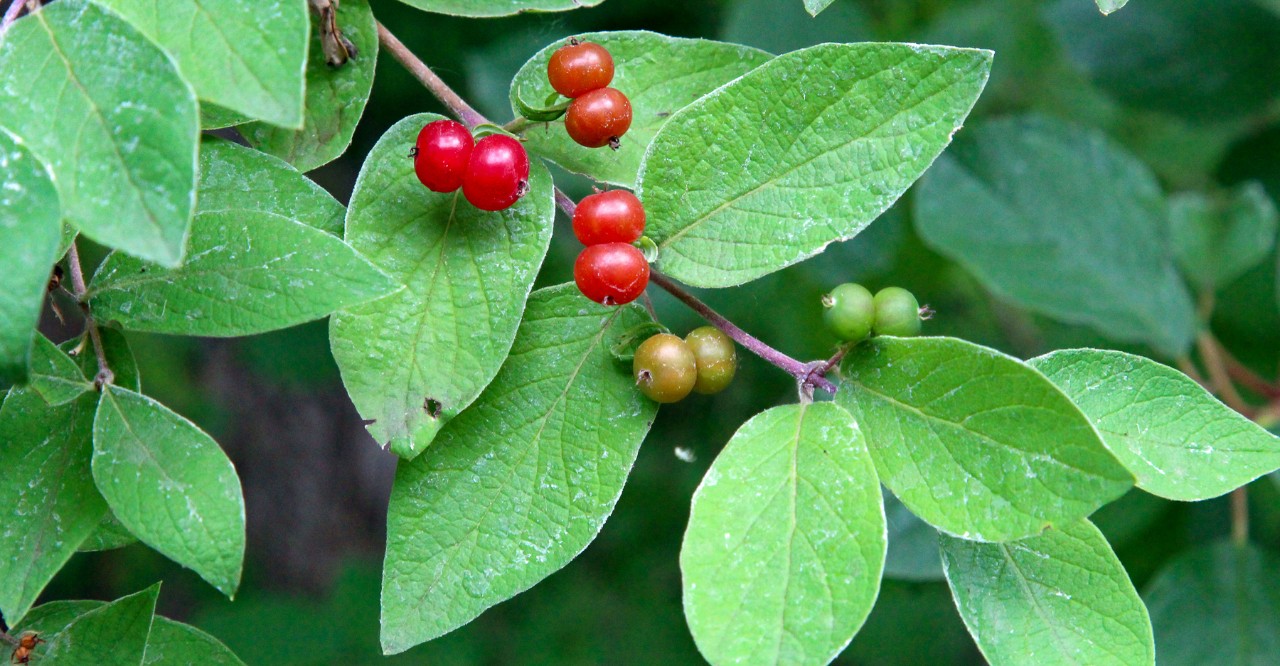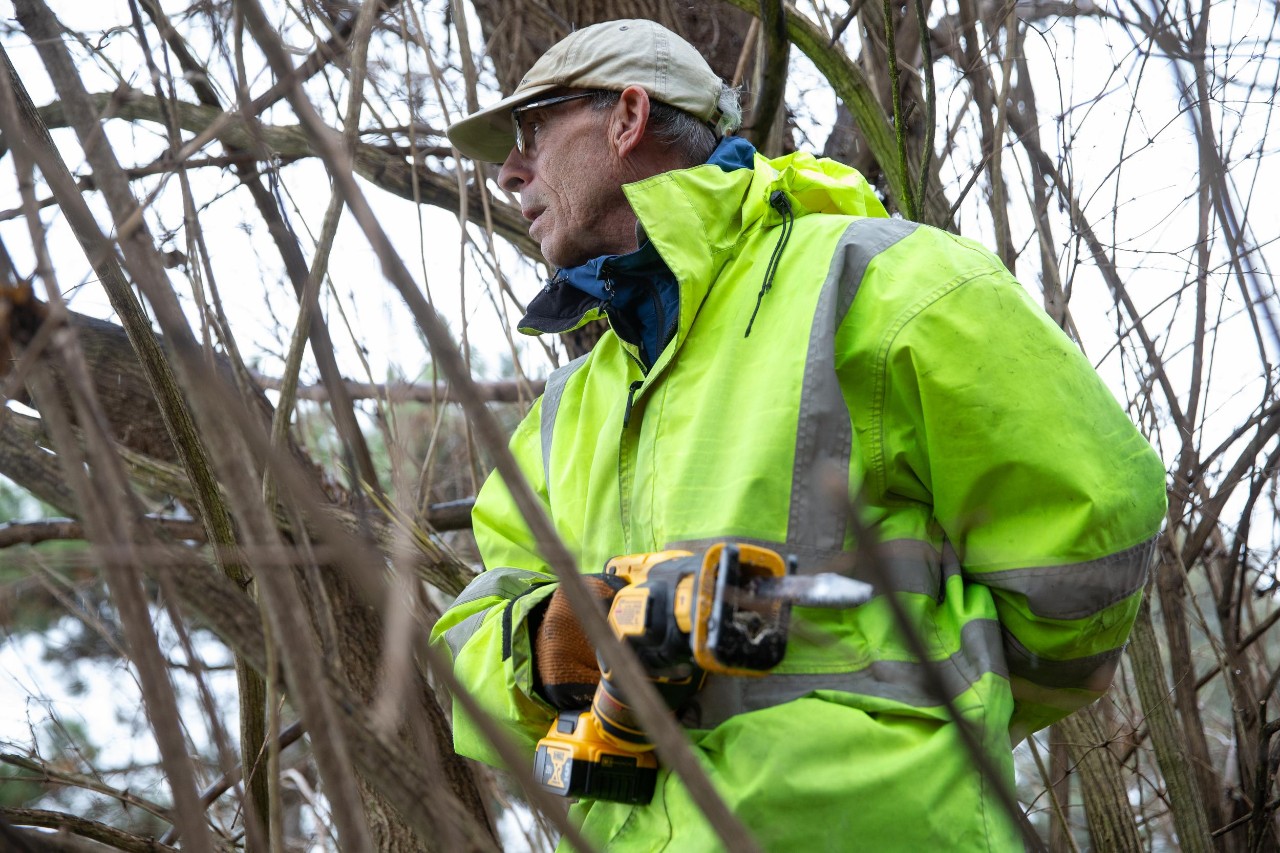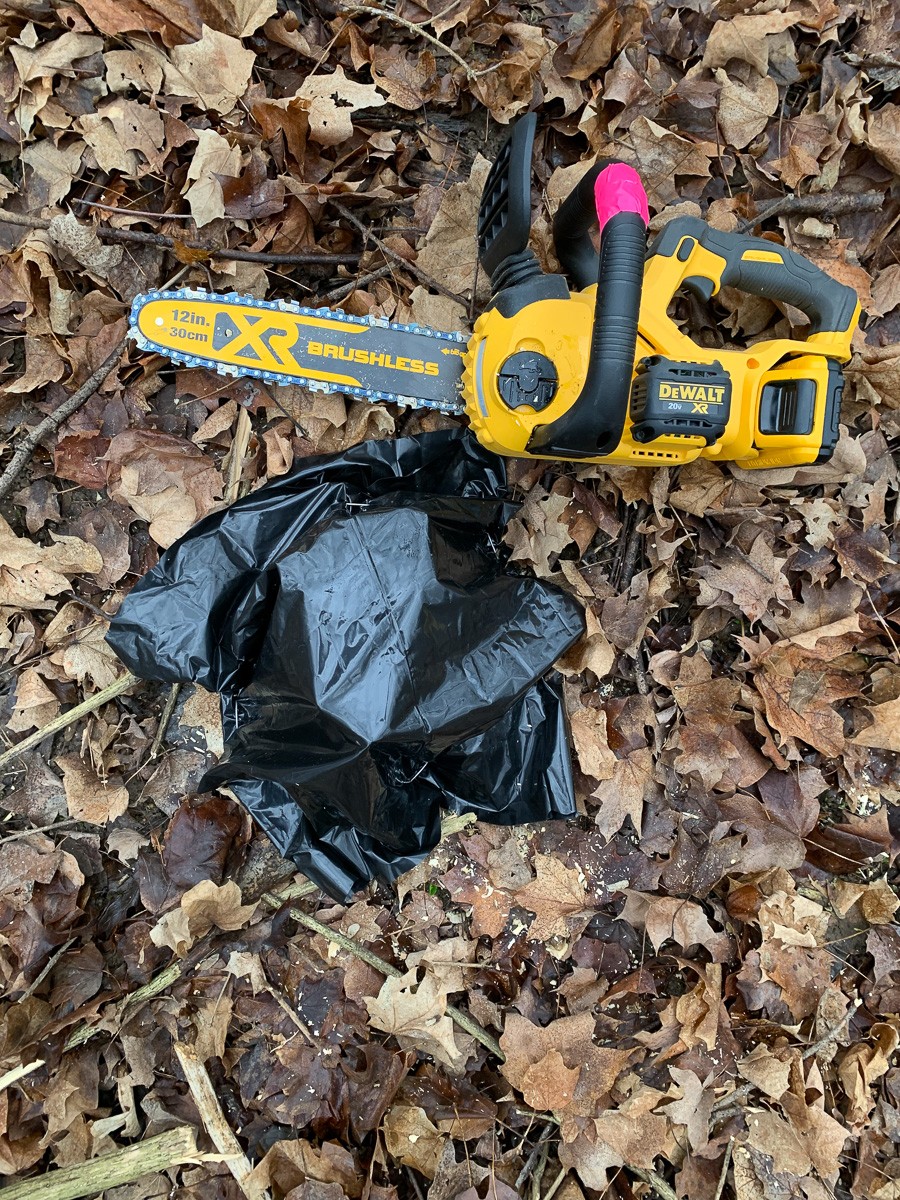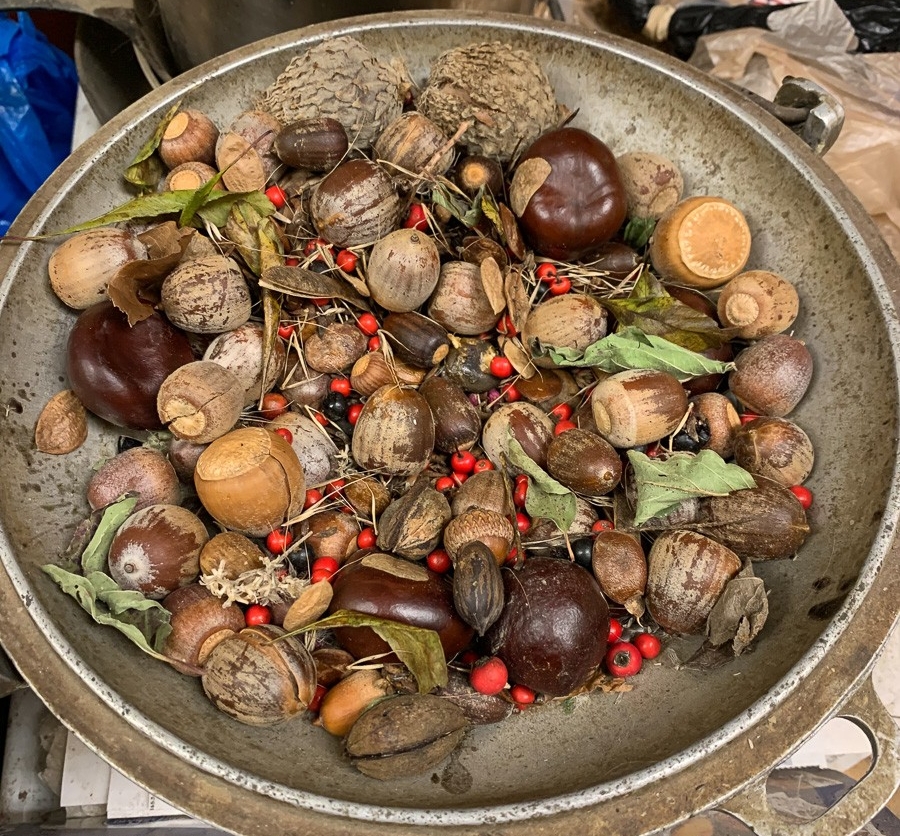
How to control honeysuckle without herbicides
UC botanist uses nontoxic way to kill invasive species
Amur honeysuckle is a common backyard pest in the eastern United States, where it crowds out most other plants.
University of Cincinnati botanist Denis Conover has been working to eradicate this invasive Asian shrub in parks and forests across Cincinnati. The bush’s thick roots grow deep and wide, making removal of an entire mature plant difficult. Foresters typically chainsaw the thick trunks of the bushes and apply toxic herbicide to the exposed surface.
But Conover has been experimenting with greener alternatives.
He has tried wrapping the trunk with different materials to block sunlight from the plant promoting new shoots. Now he is sharing his techniques with the public to help them safely remove the bushes from their own properties.

UC College of Arts and Sciences botanist Denis Conover uses a reciprocating saw to cut through the trunks of invasive Amur honeysuckle. Photo/Andrew Higley/UC Marketing + Brand
Conover appreciates how thoroughly honeysuckle has taken over many forests.
“It was introduced to North America more than 100 years ago as an ornamental but escaped cultivation,” he said. “It got into natural areas where it can totally take over.”
Nonnative plants have a history of escaping cultivation in the United States to create unexpected problems, Conover said. He points to introduced plant diseases such as chestnut blight and Dutch elm disease and insect pests such as hemlock woolly adelgid, which have devastated American forests.
Honeysuckle grows quickly, buds earlier and holds its leaves longer in the fall than other plants, shading out everything beneath it.
Eventually, you could have an entire monoculture of Amur honeysuckle where once there was a complex ecosystem of native deciduous forest.
Denis Conover, UC College of Arts and Sciences
Honeysuckle produces copious red berries that birds spread far and wide.
“Not very many caterpillars eat honeysuckle leaves. It’s a big pest. It can become so dense that not even tree seedlings can regenerate underneath it,” he said.
“So you might have some native trees poking up above the canopy. But once those trees die, that’s it. They’re not regenerating. Eventually, you could have an entire monoculture of Amur honeysuckle where once there was a complex ecosystem of native deciduous forest.”
In 1985, Conover and Donald Geiger, PhD, his mentor in the fields of plant physiology and ecological restoration, began removing Amur honeysuckle by applying herbicide to the cut stumps to prevent them from resprouting.
Tips to remove honeysuckle
- Cut the bush and any branch shoots low to the ground.
- Cover the stump and any exposed branch ends with garden plastic. Black garbage bags also work. Tie the plastic to the stump or secure it to the ground with garden wires.
- Plant native trees or bushes around the dead stump to discourage honeysuckle from returning.

Depriving a honeysuckle of sunlight will prevent new shoots from growing from its cut stump. Photo/Andrew Higley/UC Marketing + Brand
Recently, Conover has been working on honeysuckle eradication with Kate Nordyke, who owns nine acres of farmland and woods in the Cincinnati suburb of College Hill called the Evergreen Holistic Learning Center. The property has an organic garden, a horse barn and pasture surrounded by mature forest, including impressive 200-year-old beech trees.
“It’s an urban oasis. We are only 10 minutes from downtown, but you would never know it,” she said. “It’s a very special place.”
Nordyke earned degrees in biology and environmental studies at Miami University and the Union Institute and University. She and Conover worked on a botanical survey together at Spring Grove Cemetery & Arboretum. Plant specimens they collected were added to UC's Margaret H. Fulford Herbarium.
She hopes to get a conservation easement that will protect it in perpetuity. She said she wanted to be a good steward of her property. And that means addressing the invasive species that are crowding out the native plants.
“Managing invasives such as Amur honeysuckle was an important step in optimizing the ecological health of the forest,” she said. “So I felt it was an important area in which to invest time and energy.”
Nordyke doesn’t use herbicides on her property, which made it a good place to conduct experiments about the most effective nontoxic methods to kill invasive plants, Conover said.

UC botanist Denis Conover uses a chainsaw to cut through honeysuckle at ground level before covering the stump with black plastic secured from the wind with wire garden staples. Photo/Denis Conover
But removing honeysuckle is easier said than done, she said. Left to its devices, honeysuckle will resprout and grow wider and thicker than ever.
She sought advice from the Hamilton County Conservation District, which recommended covering the stumps to rob them of sunlight.
“For me, the main motivation for avoiding the use of herbicides is not wanting to put the health of myself or others at risk, including pets and wildlife,” she said.
Conover said he agrees that herbicides are overused.
“We don't really know the long-term effects of these chemicals on human health or the health of the environment,” he said.
Nordyke said some chemicals found in herbicides have been linked to cancer and can kill beneficial insects.
Conover is volunteering on Nordyke’s wooded property, experimenting with different ways of killing Amur honeysuckle and other alien plants without using herbicide. He has tried covering the stumps with different materials such as black weed control fabric, black plastic, clear plastic and even inverted black plastic flower pots. He anchors the plastic or fabric to the ground with wire garden staples.
Once the honeysuckle is gone, he plants native trees and shrubs in their place.
“These foreign plants contribute very little or nothing to the native forest ecosystem's food web and they displace the native plants which do contribute to the food web,” Conover said.

UC Educator Professor Denis Conover holds up an acorn. Oak trees provide habitat for countless species of wildlife, he said. Photo/Andrew Higley/UC Marketing + Brand
They found that simply covering the trunks in plastic such as black garbage bags and pinning it to the ground against the wind effectively kills honeysuckle without chemicals. Conover said the process is easy, effective and less expensive than herbicides, particularly since the materials can be reused.
“I tried the black plastic garbage bag method last summer on the stump of a large non-native, invasive mimosa tree that kept resprouting in my back yard. It worked,” Conover said.
His preferred method is to cut the stump at ground level and cover it with black plastic, secured to the ground with wire gardening staples.
“This elegant method is easy, effective and inexpensive. Sometimes I rake leaves over the plastic so you can’t even see it,” Conover said. “We immediately plant seeds or saplings of native trees and shrubs near the spot where the honeysuckle was cut down.”
In the past six months, Conover planted hundreds of acorns from several different species of native oak trees along with the seeds of other native trees and shrubs in Nordyke’s woods. The long list includes hickories, cherries, willows, dogwoods and hawthorns, among others, that provide food for native insects and birds.
Most native trees and shrubs can be grown easily from seed, Nordyke said.
“For every honeysuckle we cut down, we try to plant a native plant in its place,” Nordyke said. “I’ve had great success growing a variety of native plants from seeds.”
Cultivating native plants makes it less likely that honeysuckle will return, he said.
And the new plants will provide food for birds and other wildlife. Conover favors oak trees. Their leaves provide food for hundreds of species of caterpillars that birds depend on during nesting season.
“By removing the honeysuckle and replacing it with native trees and shrubs, there will certainly be a noticeable difference in the number of native caterpillars over the next few years, which will greatly benefit native birds,” Conover said.
Featured image at top: Amur honeysuckle. Photo/DipaliS/iStockPhoto

UC botanist Denis Conover plants a variety of native bushes and trees in place of the Amur honeysuckle he removes. Photo/Denis Conover
More UC Biology in the news
Next Lives Here
The University of Cincinnati is leading public urban universities into a new era of innovation and impact. Our faculty, staff and students are saving lives, changing outcomes and bending the future in our city's direction. Next Lives Here.
Related Stories
Ancient Maya used sustainable farming, forestry for millennia
June 24, 2022
University of Cincinnati researchers found evidence of sustainable agriculture and forestry spanning a millennia in one ancient Mayan city.
UC project targets pesky mosquitoes’ genes
February 21, 2022
Researchers at the University of Cincinnati examined genetic material of three species of mosquitoes responsible for killing millions of people around the world each year. In a collaboration between UC’s chemistry and biology departments, researchers revealed the surprising genetic modifications female mosquitoes undergo, in part to create the next generation. Using tools called liquid chromatography-tandem mass spectrometry, researchers found as many as 33 genetic modifications in the transfer RNA of female mosquitoes. Like DNA, transfer RNA serves as the building blocks of life, communicating the genetic code from DNA to build new proteins that regulate the body’s tissues and organs.
UC launches pioneering study of 'forever chemicals' in drinking water
May 2, 2024
UC is launching a new investigation to examine excess nutrients and contaminants in groundwater that provides drinking water for 2 million Ohioans.
